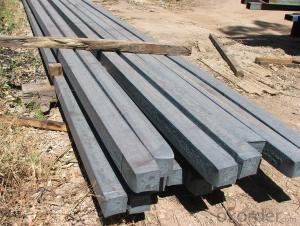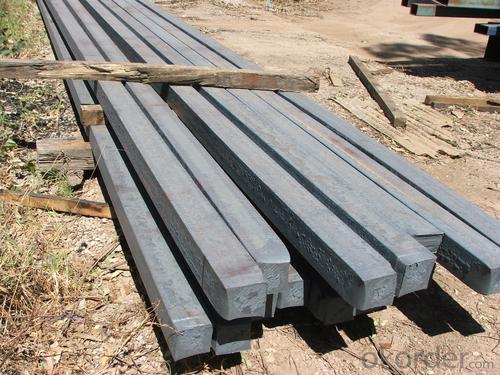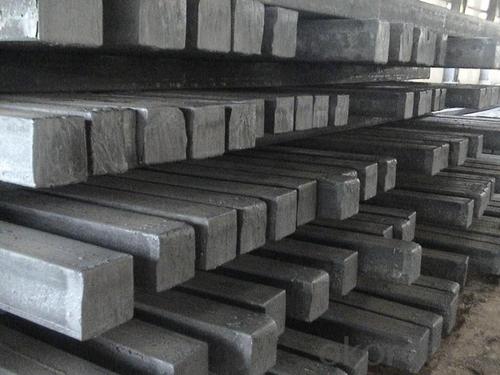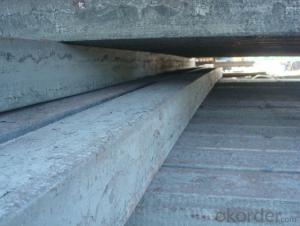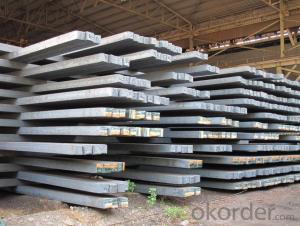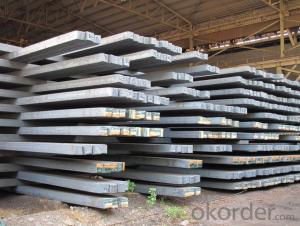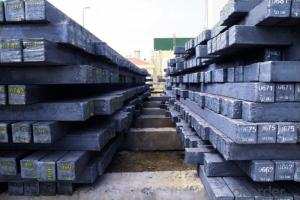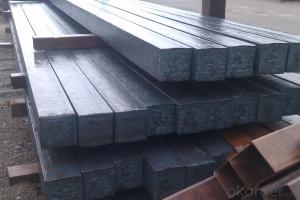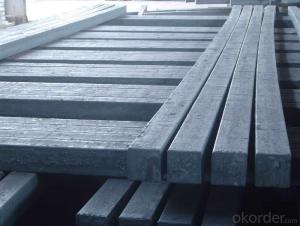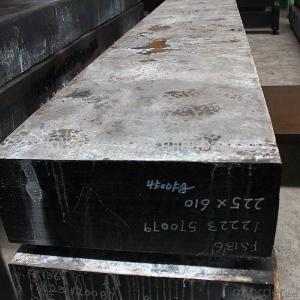Prime Q275 175mm Square Alloy Steel Billet
- Loading Port:
- Shanghai
- Payment Terms:
- TT OR LC
- Min Order Qty:
- 100 m.t.
- Supply Capability:
- 10000 m.t./month
OKorder Service Pledge
OKorder Financial Service
You Might Also Like
Structure of Prime Q275 175mm Square Alloy Steel Billet
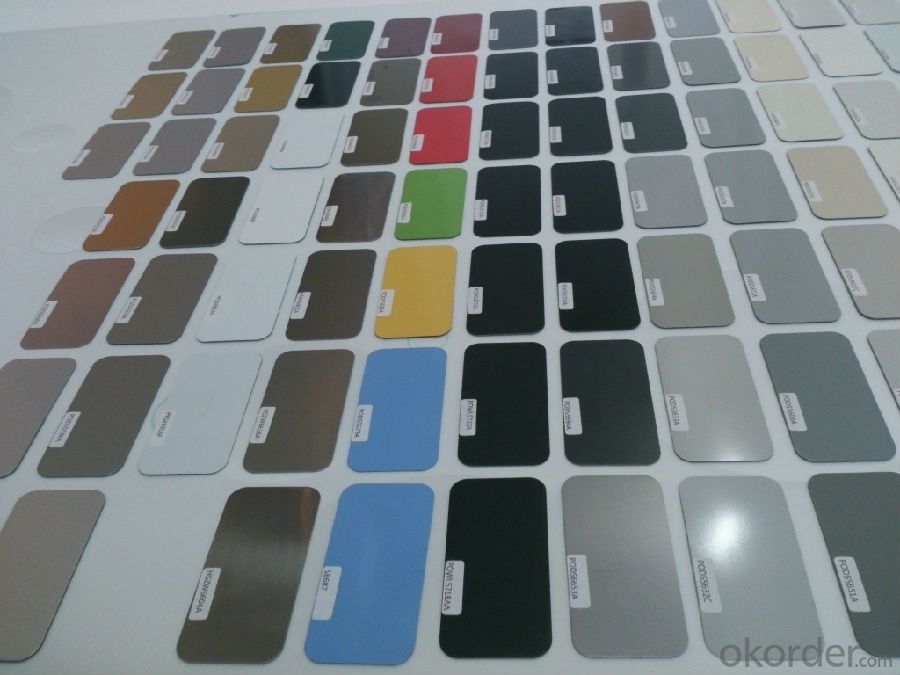
Description of Prime Q275 175mm Square Alloy Steel Billet
1. Prepainted steel coil is coated with organic layer, which provides higher anti-corrosion property and a longer lifespan than that of galvanized or galvalume steel sheets.
2. The base metals for prepainted steel coil consist of cold rolled, HDGI Steel, electro-galvanized and hot-dip alu-zinc coated steel. The finish coats of prepainted steel coil can be classified into groups as follows: polyester, silicon modified polyesters, polyvinylidene fluoride, high-durability polyester, etc.
3. The production process has evolved from one-coating-and-one-baking to double-coating-and-double-baking, and even three-coating-and-three-baking.
4. The color of the prepainted steel coil has a very wide selection, like orange, cream-colored, dark sky blue, sea blue, bright red, brick red, ivory white, porcelain blue, etc.
5. The prepainted steel coils can also be classified into groups by their surface textures, namely regular prepainted sheets, embossed sheets and printed sheets.

Main Feature of Prime Q275 175mm Square Alloy Steel Billet
They were one of several reasons for the wind to be taken out of the sails of the recent oil price momentum. Kuwait’s oil minister said that his country would only commit to a production freeze if all major producers are involved, including Iran. We also had Goldman telling us that oil markets will not rebalance at $40/bbl as it throws a lifeline to cash-strapped US producers.
If it is talk of a production freeze that is behind the rally it shows how low expectations have fallen. It is in the nature of oil people to talk the market up. Any bullish crumb is given exaggerated significance and any port in a storm will do. It is all but fact that the oil market will be tighter in the second half of this year when seasonal demand shoots up and US production continues to decline. It was the same picture last year. If OPEC and key non-OPEC production is frozen that will ensure the daily surplus will fall, but in all likelihood there will still be a surplus and there is an enormous global stockbuild to burn off.
Applications of Prime Q275 175mm Square Alloy Steel Billet
A. Corrugated design makes it excellent waterproof performance
B. Materials as prepainted steel sheets, galvanized steel sheets, galvalume (Al-Zn coated sheets) are available to make corrugated sheet.
C.Those material are durable, anti-corrosion in bad weather for 20-30 years based on it's Zinc(Galvanized) coating or AZ (Galvalume) coating.
D. Different shape of the sheet make it suitable for any style of buildings.
E.Easy to install, no need special tools to fix the sheet.
F.Light weight due to high strength to weight ratio of steel. Light weight means easier handling lower shipping costs, easier installation
G. Different color is availbe base on the RAL Standard make your building more beautiful.
H. We will provide the best solutions if you don't have a exact idea of the specification you want for the steel sheet based on your weather conditions, engineering structure, construction budget and so on.

Specifications of Prime Q275 175mm Square Alloy Steel Billet
Product | Billet |
Material Grade | SGCC / SGCH / DX51D+AZ, etc |
Thickness | 0.6-3.0mm |
Width | 500-1500mm |
Tolerance | Thickness: +/-0.02mm , Width:+/-2mm |
Zinc-coating | Z30-150g/m2 |
Technique | Raw material: Hot rolled steel coil --> Cold rolled_>hot dipped galvalume |
Surface | Dried, Chromated, Unoiled |
Spangle | Regular spangle , small spangle, zero spangle |
ID | 508MM 610MM |
Coil weight | 1-25MT |
Export package | Cardboard inner sleeves, Waterproof paper, galvanized steel covered and steel strip packed |
FAQ of Prime Q275 175mm Square Alloy Steel Billet
We have organized several common questions for our clients,may help you sincerely:
1. How Can I Visit There?
Our company is located in Tianjin City, China, near Beijing. You can fly to Tianjin Airport Directly. All our clients, from home or aboard, are warmly welcome to visit us!
2. How Can I Get Some Sample?
Poor trade figures from China punctured commodity optimism yesterday although they came with warnings that perhaps the numbers were distorted by Chinese New Year celebrations and we will have to wait for the March figures to gain a true picture of the state of China’s landing. Exports for February were -25.4% and imports -13.8% year-on-year.
- Q: Are steel billets used in the manufacturing of construction machinery?
- Steel billets are a common choice for the manufacturing of construction machinery. They serve as semi-finished products, acting as raw materials across various industries, including construction machinery manufacturing. To create these billets, molten steel is cast into a solid form and then undergoes additional shaping and sizing processes. The high strength, durability, and versatility of steel billets make them well-suited for constructing robust components and structures in construction machinery. Examples of parts that can be manufactured using steel billets include chassis, frames, buckets, booms, and arms, among others. By utilizing steel billets, construction machinery becomes capable of withstanding the demanding conditions and heavy loads commonly encountered in construction projects.
- Q: How are steel billets used in the production of structural sections?
- Steel billets are an essential raw material in the production of structural sections. These sections, such as beams, columns, and girders, are crucial components in the construction industry and are used to create sturdy and durable buildings, bridges, and other infrastructure. To begin the production process, steel billets are heated to extremely high temperatures in a furnace. This process, known as "hot rolling," makes the steel more malleable and easier to shape. Once the billets have reached the required temperature, they are passed through a series of rollers to gradually reduce their thickness and shape them into the desired structural section. The hot rolling process ensures that the steel maintains its strength and structural integrity while being shaped. It also helps to align the grain structure of the steel, resulting in improved strength and ductility. Moreover, the hot rolling process eliminates any internal stresses within the steel, making it less prone to cracking or failure. After the hot rolling process, the structural sections are cooled down and then cut to the desired length. They may also undergo additional treatments, such as straightening or surface finishing, to meet specific requirements or improve their aesthetics. Overall, steel billets play a crucial role in the production of structural sections. By providing the raw material that is shaped and processed, steel billets ensure that the resulting sections possess the necessary strength, durability, and stability required for construction projects.
- Q: What are the different types of cutting processes used for shaping steel billets?
- There are several different types of cutting processes used for shaping steel billets. These processes include: 1. Bandsaw cutting: Bandsaw cutting is a widely used method for cutting steel billets. It involves using a continuous band of toothed metal blade to cut through the billet. Bandsaws are known for their ability to cut through thick sections of steel quickly and accurately. 2. Abrasive cutting: Abrasive cutting involves using an abrasive wheel or disc to cut through the steel billet. This method is commonly used for cutting smaller billets or for cutting shapes and contours into the billet. Abrasive cutting is known for its versatility and ability to produce smooth and precise cuts. 3. Plasma cutting: Plasma cutting is a thermal cutting process that uses a high-velocity jet of ionized gas to melt and remove the steel from the billet. This method is often used for cutting thick sections of steel or for cutting intricate shapes. Plasma cutting is known for its speed and ability to produce clean cuts. 4. Waterjet cutting: Waterjet cutting is a process that uses a high-pressure jet of water to cut through the steel billet. In some cases, abrasive particles may be added to the water to enhance the cutting ability. Waterjet cutting is known for its ability to cut through thick sections of steel without creating heat-affected zones or distortion. 5. Laser cutting: Laser cutting involves using a high-powered laser beam to melt and vaporize the steel billet. The laser beam is guided by computer controls to cut the desired shape. Laser cutting is known for its precision and ability to cut intricate shapes with minimal distortion. These are just a few examples of the different types of cutting processes used for shaping steel billets. Each process has its own advantages and is chosen based on factors such as the size of the billet, the desired shape, and the required accuracy.
- Q: Can steel billets be coated for improved corrosion resistance?
- Yes, steel billets can be coated with various materials such as zinc, aluminum, or polymer coatings to enhance their corrosion resistance.
- Q: Are steel billets used in the renewable energy sector?
- Yes, steel billets are used in the renewable energy sector. Steel is a versatile material that is used in the construction of various renewable energy infrastructure components. For example, steel billets are commonly used in the manufacturing of wind turbine towers, which are essential for the generation of wind energy. Steel billets provide the necessary strength and durability to support the enormous weight and withstand the harsh environmental conditions that wind turbines are exposed to. Additionally, steel billets are also utilized in the construction of solar power systems, such as solar panel mounting structures and support frames. These structures require a strong and reliable material like steel to ensure the stability and longevity of the solar panels. Therefore, steel billets play a crucial role in supporting and facilitating the growth of the renewable energy sector.
- Q: How is the quality of steel billets determined?
- The quality of steel billets is determined through various factors including chemical composition, physical properties, and visual inspection. Chemical composition analysis involves measuring the levels of different elements present in the billets such as carbon, manganese, and sulfur, as well as checking for any impurities. Physical properties such as tensile strength, hardness, and toughness are tested to ensure the billets meet the required specifications. Visual inspection is also performed to identify any defects like cracks, surface abnormalities, or unevenness. Combining these assessments helps determine the overall quality of steel billets.
- Q: How do steel billets contribute to the shipbuilding industry?
- Steel billets are a crucial raw material in the shipbuilding industry as they serve as the starting point for manufacturing various components, such as hulls, decks, and structural beams. These billets are transformed into the desired shapes and sizes through processes like rolling and forging, ensuring the strength and durability needed for marine applications. With their high tensile strength and resistance to corrosion, steel billets provide the foundation for constructing safe and reliable ships that can withstand the harsh conditions of the sea.
- Q: Are steel billets used in the production of electrical transmission towers?
- Yes, steel billets are commonly used in the production of electrical transmission towers. Steel billets are the initial form of the steel used in the manufacturing process. They are typically hot rolled into various shapes and sizes, including the sections and components necessary for constructing transmission towers. The high strength and durability of steel makes it an ideal material for these structures, as they need to withstand harsh environmental conditions and support heavy electrical conductors. Furthermore, steel offers excellent electrical conductivity properties, which is crucial for the efficient transmission of electricity through the towers. Overall, steel billets play a crucial role in the production of electrical transmission towers, ensuring the strength, durability, and efficiency of these structures.
- Q: How are steel billets used in the manufacturing of industrial compressors?
- Industrial compressors require steel billets as a crucial part of their manufacturing process. These billets, essentially semi-finished steel products in the shape of a rectangular solid, are the starting material for making different compressor components. To begin with, steel billets are heated to high temperatures and then passed through rolling mills to shape them into specific forms like bars, rods, or sheets. These processed steel billets are then used to fabricate important compressor components such as the crankshaft, connecting rods, cylinder blocks, and piston rings. The crankshaft, which converts the piston's reciprocating motion into rotational motion, is typically forged from a steel billet. The billet undergoes controlled heating, shaping, and machining processes to achieve the desired shape and strength necessary to withstand the high pressures and forces within the compressor. Likewise, connecting rods, responsible for connecting the piston to the crankshaft, are also made from steel billets. These billets are machined precisely and undergo various heat treatment processes to ensure optimal strength and durability. Cylinder blocks, the primary structural frame of the compressor, are often casted from steel billets. The billets are melted and poured into molds to achieve the desired shape. Once solidified, further machining is performed on the cylinder block to create the cylinder bores, mounting surfaces, and other necessary features. Moreover, steel billets are utilized for producing piston rings, which play a crucial role in maintaining proper compression and preventing leakage. The billets are machined and then subjected to heat treatment processes to enhance wear resistance and ensure a precise fit within the cylinder. In summary, steel billets are indispensable in the manufacturing of industrial compressors as they provide the raw material for creating vital components. The ability to shape and process steel billets enables the production of robust, durable, and high-performance compressors capable of meeting the demanding requirements of various industries.
- Q: How are steel billets used in the manufacturing of oil and gas equipment?
- Steel billets are a crucial component in the manufacturing of oil and gas equipment. These billets, which are essentially semi-finished steel products, serve as the starting material for the fabrication of various equipment used in the oil and gas industry. One of the primary applications of steel billets is in the production of pipes. Oil and gas pipes need to withstand high pressure, extreme temperatures, and corrosive environments. Steel billets provide the raw material necessary to create seamless or welded pipes that can meet these demanding requirements. The billets are heated, pierced, and elongated through a process called extrusion, which enables the formation of seamless pipes. Alternatively, they can be rolled and welded to create longitudinally welded pipes. Steel billets are also used in the manufacturing of valves, fittings, and flanges. Valves play a critical role in controlling the flow of oil and gas within pipelines and equipment. Fittings, such as elbows, tees, and reducers, are used to connect pipes together or change their direction. Flanges, on the other hand, provide a means of connecting pipes, valves, and other equipment by bolting them together. All of these components require the use of steel billets as the starting material, which are then machined, shaped, and heat-treated to meet the necessary specifications and standards. Furthermore, steel billets are utilized in the fabrication of drilling equipment and offshore structures. Drilling equipment, including drill bits, drill collars, and drill pipes, are essential for oil and gas exploration and extraction. These components are subjected to intense forces and harsh conditions, making the use of high-quality steel billets crucial to ensure their strength and durability. Offshore structures, such as platforms and rigs, also require steel billets to construct the framework and support systems that can withstand the challenging marine environment. In summary, steel billets are indispensable in the manufacturing of oil and gas equipment. They serve as the raw material for pipes, valves, fittings, flanges, drilling equipment, and offshore structures. By starting with high-quality steel billets, manufacturers can produce durable and reliable equipment that can withstand the demanding conditions of the oil and gas industry.
Send your message to us
Prime Q275 175mm Square Alloy Steel Billet
- Loading Port:
- Shanghai
- Payment Terms:
- TT OR LC
- Min Order Qty:
- 100 m.t.
- Supply Capability:
- 10000 m.t./month
OKorder Service Pledge
OKorder Financial Service
Similar products
Hot products
Hot Searches
Related keywords
